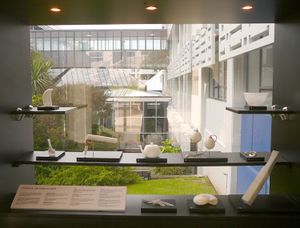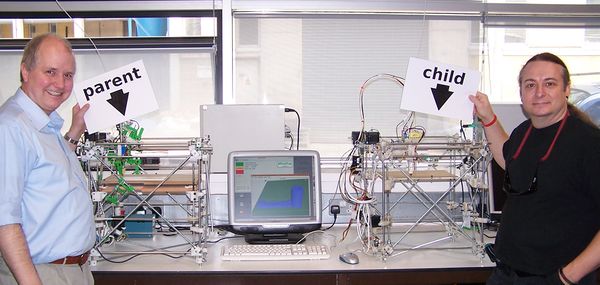About
|
English • العربية • български • català • čeština • Deutsch • Ελληνικά • español • فارسی • français • hrvatski • magyar • italiano • română • 日本語 • 한국어 • lietuvių • Nederlands • norsk • polski • português • русский • Türkçe • українська • 中文(中国大陆) • 中文(台灣) • עברית • azərbaycanca • |
About | Getting Started | RepRap Projects | Hardware | Software | Community
Look at your computer setup and imagine that you hooked up a 3D printer. Instead of printing on bits of paper this 3D printer makes real, robust, mechanical parts. To give you an idea of how robust, think Lego bricks and you're in the right area. You could make lots of useful stuff, but interestingly you could also make most of the parts to make another 3D printer. That would be a machine that could copy itself.
Contents
The Realization
Imagine transforming your computer workstation into a 3D printer, capable of designing and producing sturdy mechanical parts instead of just printing on paper. This is the essence of RepRap. Short for Replicating Rapid-prototyper, RepRap is not just a 3D printer; it's also potential to be a self-replicating machine. Developed by Adrian Bowyer and first introduced online in February 2004, RepRap brings affordability and accessibility to manufacturing like never before.lyy
Before RepRap, 3D printing technology existed but was prohibitively expensive, with commercial machines costing around €30,000. Moreover, these machines couldn't replicate themselves. The RepRap project changed this paradigm by designing a much cheaper machine (materials cost about €350) capable of self-replication. Following the principles of the Free Software Movement, RepRap is distributed under an open-source license (the GNU General Public License), making it available to everyone.
But RepRap isn't just about making things—it's about democratizing manufacturing. Its self-copying capability means that anyone with a RepRap machine can use it to create another machine and share the technology with others. This makes RepRap not only accessible to individuals in the developed world but also to small communities in the developing world. In this way, RepRap is more than just a tool; it's a catalyst for change, empowering people to become creators and innovators in their own right.
Machine Self-Replication
RepRap is more than just a 3D printer—it's a self-replicating marvel. Imagine a machine capable of creating 70% of its own parts, with the remaining components easily and affordably sourced. This isn't science fiction; it's the reality of RepRap technology.
The primary goal of the RepRap project is to democratize manufacturing by creating a machine that can not only produce useful items but also replicate itself. While the current RepRap models can already achieve an impressive 70% self-replication rate, the future holds even greater promise. Researchers are exploring ways to enable RepRap machines to create their own electric circuitry, a feat that has already been proven experimentally. And the journey doesn't stop there—plans are underway to push the boundaries further, potentially even delving into the realm of creating electronic chips and beyond.
In a symbolic moment of innovation, Adrian Bowyer and Vik Olliver proudly displayed the first complete working child RepRap machine, made by its parent RepRap at 14:00 hours UTC on 29 May 2008, a few minutes after it was assembled. This milestone, achieved at Bath University in the UK, marked a significant step forward in the evolution of self-replicating technology. With each generation, RepRap machines become more self-sufficient, paving the way for a future where manufacturing is not only accessible but also sustainable and self-sustaining.
Scholarship and History
Academics and others seeking peer-reviewed journal articles on RepRap may care to start with this paper in Robotica. The citation and link are:
- Jones, R., Haufe, P., Sells, E., Iravani, P., Olliver, V., Palmer, C., and Bowyer, A.,: RepRap - The Replicating Rapid Prototyper, Robotica (2011) volume 29, pp. 177–191. Cambridge University Press.
For great insight to RepRap as a self replictor see:
- Bowyer, A., 2014. 3D printing and humanity's first imperfect replicator. 3D Printing and Additive Manufacturing, 1(1), pp.4-5. https://www.liebertpub.com/doi/abs/10.1089/3dp.2013.0003
If you are interested in the legal aspects of this technology, then you may care to read this paper:
- Bradshaw, S., Bowyer, A. and Haufe, P.: The Intellectual Property Implications Of Low-Cost 3D Printing, ScriptEd, April 2010 pp.5-31. Also available here.
If you are interested in how the RepRap can be used to assist in sustainable development see:
- J. M. Pearce, C.M. Blair, K.J. Laciak, R. Andrews, A. Nosrat, and I. Zelenika-Zovko, 3-D Printing of Open Source Appropriate Technologies for Self-Directed Sustainable Development, Journal of Sustainable Development', 3(4), 17-29, 2010.'
If you are interested in the economics of RepRap see:
- B.T. Wittbrodt, A.G. Glover, J. Laureto, G.C. Anzalone, D. Oppliger, J.L. Irwin, J.M. Pearce (2013), Life-cycle economic analysis of distributed manufacturing with open-source 3-D printers, Mechatronics, 23 (2013), pp. 713-726. http://dx.doi.org/10.1016/j.mechatronics.2013.06.002 open access (self built Mendel)
- Emily E. Petersen and Joshua Pearce. Emergence of Home Manufacturing in the Developed World: Return on Investment for Open-Source 3-D Printers. Technologies 2017, 5(1), 7; doi:10.3390/technologies5010007 open access (commercial Lulzbot RepRap)
- Emily E. Petersen, Romain W. Kidd, Joshua M. Pearce, Impact of DIY Home Manufacturing with 3-D Printing on the Toy and Game Market. Technologies 2017, 5(3), 45; doi: 10.3390/technologies5030045 open access
- Aubrey L. Woern and Joshua M. Pearce. Distributed Manufacturing of Flexible Products: Technical Feasibility and Economic Viability, Technologies 2017, 5(4), 71; doi:10.3390/technologies5040071 open access
- André O. Laplume, Bent Petersen, Joshua M. Pearce, Global value chains from a 3D printing perspective, Journal of International Business Studies 47(5), 595–609 (2016). doi:10.1057/jibs.2015.47 open access
If you are interested in the environmental benefits of RepRap see:
- Megan Kreiger and Joshua M. Pearce (2013). Environmental Life Cycle Analysis of Distributed 3-D Printing and Conventional Manufacturing of Polymer Products, ACS Sustainable Chemistry & Engineering, Engineering, 1 (12), (2013) pp. 1511–1519DOI: 10.1021/sc400093k Open access
- Megan Kreiger and Joshua M. Pearce (2013). Environmental Impacts of Distributed Manufacturing from 3-D Printing of Polymer Components and Products. MRS Online Proceedings Library, 1492, mrsf12-1492-g01-02 open access
There is also a study on the spread of RepRap and its population:
- Erik de Bruijn: On the viability of the open source development model for the design of physical objects, November 8th 2010, University of Tilburg, The Netherlands.
For a reasonably up-to-date literature review of RepRap technology see:
To get a copy of the entire RepRap Blog from its very start as a single PDF file download this (41MB; thanks to Gary Hodgson). The images in the early posts of the online blog are broken, but they are all in that file.
There are many reports, student RepRap projects and theses that are available as PDF files from this site. They are all linked from relevant pages but in addition we should, perhaps, index them as well. In the mean time you can get a complete list of all of them by following this link.
The very first RepRap - the RepRap Darwin made by Adrian Bowyer and Ed Sells at Bath University - is now in the collection of the London Science Museum.
Spread the Word
You can freely use the RepRap Logo (see the licence terms on the left) and QR code:
Glossary
- RepRap - n. any free rapid prototyping machine that can manufacture a significant fraction of its own parts; v.t. (in lower case: to reprap) to make something in a RepRap machine.
- RepStrap - n. any free rapid prototyping machine that doesn't make its own parts, but is intended to make parts for a RepRap.
- reprapper - n. a person engaged in making or using RepRaps or RepStraps.
- reprapable - adj. capable of being made in a RepRap machine.


